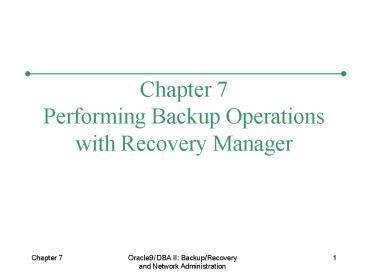Oracle9i DBA II: BackupRecovery and Network Administration - PowerPoint PPT Presentation
1 / 30
Title:
Oracle9i DBA II: BackupRecovery and Network Administration
Description:
Describe the difference between an image copy and a backup of a data file. Chapter 7 ... commands execute immediately; job commands executed using RUN command ... – PowerPoint PPT presentation
Number of Views:45
Avg rating:3.0/5.0
Title: Oracle9i DBA II: BackupRecovery and Network Administration
1
Chapter 7Performing Backup Operations with
Recovery Manager
2
Chapter Objectives
- Identify the tablespaces and data files
associated with the target database using the
REPORT command - Manually allocate a channel to perform backup
operations
3
Chapter Objectives (Cont.)
- Include a snapshot of the control file when
backing up a tablespace - Distinguish between a full backup and a Level 0
backup - Explain the difference between differential and
cumulative incremental backup strategies
4
Chapter Objectives (Cont.)
- Perform a Level 0 backup of multiple tablespaces
using the BACKUP command - Describe the difference between an image copy and
a backup of a data file
5
Basic Features
- Can create
- Image copies - exact duplicate of entire file
- Incremental backups
- Used blocks only
- Changed blocks only
6
Report Command
- Provides information regarding repository contents
7
Report Example
8
Report Database Schema
9
RMAN Command Types
- Stand-alone command
- Single command
- Executes immediately
- Job command
- Block of commands
- Enclosed in curly braces
- Each command terminated by semicolon
- Executed in sequence
10
Job Command Example
11
ALLOCATE Command
12
ALLOCATE Command Keywords
- CHANNEL names the channel
- DEVICE TYPE
- DISK magnetic disk
- SBT_TAPE or TAPE magnetic tape
13
BACKUP Command Options
14
BACKUP Command Options (cont)
15
Full vs. Whole Backup
- Full
- Creates copy of all used data blocks
- Whole
- Backup of all files needed in the event that
recovery becomes necessary
16
Elements of the FORMAT Option
17
Output of Executed BACKUP Command
18
Example Backup of Archived Redo Log Files
19
Incremental Backup
- Five backup levels
- Level 0
- Copies same data as full backup
- Serves as the base level of incremental backup
strategy - Levels 1-4
- Backup changed blocks since previous incremental
backup
20
Example Level 0 Backup of Tablespaces
21
Differential vs. Cumulative
- Differential incremental backup
- Copies data blocks changes after last Level n or
lower backup - Default
- Cumulative incremental backup
- Copies data blocks changes after last Level n-1
or lower backup - Requires CUMULATIVE keyword
22
Differential Incremental Backup
23
Cumulative Incremental Backup
24
Incremental Backups and Archiving Modes
- ARCHIVELOG database
- Can be open
- SCN used to identify changed data blocks
- NOARCHIVELOG database
- Requires SCN in all files to be consistent
- Database must be mounted, but not opened
25
Image Copies
- Creates exact duplicate of file
- Similar to operating system copy
- Can be used as part of a full or incremental
backup strategy - RMAN automatically checks for corruption when
created
26
COPY Command Syntax
27
COPY Command Example
28
Chapter Summary
- RMAN can be used to back up changed data blocks
or to create an image copy - REPORT command can identify data files meeting
certain criteria - Stand-alone commands execute immediately job
commands executed using RUN command
29
Chapter Summary (Cont.)
- ALLOCATE command used to manually allocate a
channel - Full backup creates copy of all used data blocks
in a file - Differential backs up changes since last Level n
or lower Cumulative backs up changes since last
Level n -1 or lower
30
Chapter Summary (Cont.)
- Level 0 serves as baseline backs up same data
blocks as a full backup - Full backup cannot serve as a baseline
- Cumulative takes longer than differential
backups, but recovery is faster - Image copy is an exact copy of file, including
empty data blocks































